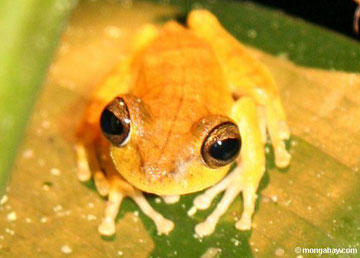Amphibians face mass extinction
Amphibians face mass extinction
mongabay.com
August 11, 2008
|
|
Amphibians are in big trouble. At least one third of the world’s 6,300 known species are threatened with extinction, while at least 200 species have gone extinct over the past 20 years. Worryingly the outbreak of a deadly fungal disease, chytridiomycosis, is spreading throughout the tropics leaving millions of victims. A new study, published in the early edition of the Proceedings of the National Academy of Sciences, warns that there is “little time to stave off a potential mass extinction” of frogs, salamanders, and caecilians.
“The rate of extinction of amphibians is truly startling,” write authors David Wake and Vance Vredenburg. “A recent study estimates that current rates of extinction are 211 times the background extinction rate for amphibians, and rates would be as high as 25,000-45,000 times greater if all of the currently threatened species go extinct”
Wake and Vredenburg note that species from montane tropical regions are particularly at risk, although some species — notably those that thrive in human-modified landscapes — are faring well. They suggest that at least some species of amphibians “will survive the current extinction event on their own or with help,” especially as new conservation efforts seek to protect vulnerable species through captive breeding programs ad reintroduction. The authors add that scientists are working to develop ways to treat chytridiomycosis.
 Photo by Rhett A. Butler |
Still in the near term many species of amphibian are likely to go extinction due to continuing habitat destruction, the effects of introduced species, pollution, disease, and the impact of climate change. These factors may interact synergistically to increase threats to amphibian populations. All these threats are principally driven by humans, argue the authors.
“We can be sure that behind all of these activities is one weedy species, Homo sapiens, which has unwittingly achieved the ability to directly affect its own fate and that of most of the other species on this planet,” they write. “It is an intelligent species that potentially has the capability of exercising necessary controls on the direction, speed, and intensity of factors related to the extinction crisis.”
“Education and changes of political direction take time that we do not have, and political leadership to date has been ineffective largely because of so many competing, short-term demands. A primary message from the amphibians, other organisms, and environments, such as the oceans, is that little time remains to stave off mass extinctions, if it is possible at all.”
David B. Wake and Vance T. Vredenburg (2008). Are we in the midst of the sixth mass extinction? A view from the world of amphibians. PNAS Online Early Edition for the week of August 11-15, 2008.
Related articles
As amphibians leap toward extinction, alliance pushes “The Year of the Frog”
(12/31/2007) With amphibians experiencing dramatic die-offs in pristine habitats worldwide, an alliance of zoos, botanical gardens and aquariums has launched a desperate public appeal to raise funds for emergency conservation measures. Scientists say that without quick action, one-third to one-half the world’s frogs, toads, salamanders, newts and caecilians could disappear.
 |
Scientists find possible cure for global amphibian-killing disease
(5/23/2007) Scientists have discovered a possible treatment for the fungal disease that has killed millions of amphibians worldwide. Presenting Wednesday at the General Meeting of the American Society for Microbiology in Toronto, Professor Reid N. Harris at James Madison University reported that Pedobacter cryoconitis, a bacteria found naturally on the skin of red-backed salamanders, wards off the deadly chytridiomycosis fungus, an infection cited as a contributing factor to the global decline in amphibians observed over the past three decades.
 |
Bad news for frogs; amphibian decline worse than feared
(4/16/2007) Chilling new evidence suggests amphibians may be in worse shape than previously thought due to climate change. Further, the findings indicate that the 70 percent decline in amphibians over the past 35 years may have been exceeded by a sharp fall in reptile populations, even in otherwise pristine Costa Rican habitats. Ominously, the new research warns that protected areas strategies for biodiversity conservation will not be enough to stave off extinction. Frogs and their relatives are in big trouble.